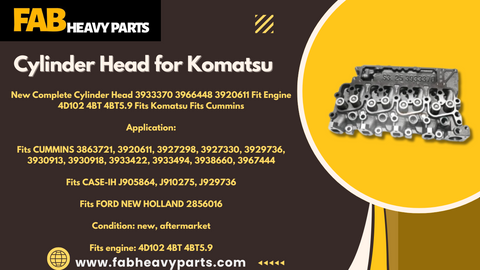
Within the intricate system of a vehicle's engine, various components collaborate seamlessly to facilitate combustion. Among these, the cylinder head stands out as a pivotal element, serving as the guardian of essential moving parts. Should the unfortunate event of a cracked cylinder head occur, swift action in the form of repair or replacement becomes imperative to avert potential extensive damage to the engine.

What Is a Cylinder Head?
The cylinder head of a vehicle is an essential component that is mounted to the top of the engine block, with the crucial head gasket positioned between these two elements to ensure a secure seal. This intricate part plays a pivotal role in the functioning of the engine by creating a designated space for the spark plugs and the intake and exhaust valves. In engines featuring an overhead cam layout, the cylinder head also accommodates the camshaft, further underscoring its significance in the engine's operation.
Within the cylinder head, there are a myriad of passageways, commonly referred to as tracts or ports, which serve distinct purposes. Some of these passageways facilitate the airflow to the inlet valves, while others provide a pathway for the exhaust gases to exit the engine. By sealing the tops of the cylinders, the cylinder head effectively creates combustion chambers, with the spark plugs protruding into these chambers from the cylinder head to initiate the ignition process. The valves situated atop each cylinder are orchestrated by the camshaft.
The intake valve enables the mixture of air and fuel to enter the cylinder before closing to allow for compression when the piston ascends within the cylinder. Subsequently, the compressed fuel is ignited by the spark plugs. The resultant expanding gases propel the piston away from the cylinder head during the combustion stroke. As the piston retracts towards the cylinder head post-combustion, the exhaust valve opens to facilitate the expulsion of the gases. The precise timing of these events is ensured by the timing belt or chain, which coordinates the engine's internal processes at the correct intervals, thus optimising the engine's performance.
The cylinder head plays a crucial role in the operation of an engine by performing the following tasks:
- Sealing the combustion chamber and cylinder block: The cylinder head ensures that the combustion process within the chamber is contained and effectively sealed to maintain optimal pressure levels for engine performance.
- Housing the intake and exhaust valves: Within the cylinder head, the intake and exhaust valves are housed, controlling the flow of air and fuel into the combustion chamber and the expulsion of exhaust gases after combustion.
- Creating the combustion chamber shape: The design of the combustion chamber within the cylinder head is essential for promoting efficient fuel combustion and ensuring optimal engine performance.
- Dissipating heat produced from combustion: As the combustion process generates significant heat, the cylinder head is responsible for dissipating this heat efficiently to prevent overheating and maintain the engine's operational temperature within safe limits.
Components
The standard cylinder head comprises several essential components that play crucial roles in the functioning of an engine:
- Head Gasket: This vital component provides a seal between the cylinder head and engine block, preventing coolant and oil from mixing in the tracts. Additionally, the head gasket is instrumental in ensuring proper compression within the cylinders.
- Camshaft: The camshaft is responsible for pressing against the valves or rocker arms to regulate the intake of air and fuel and the expulsion of exhaust gases. In engines without an overhead-cam design, the camshaft is typically mounted within the cylinder block.
- Valves: Engine valves function as gates, controlling the flow of air and gases into and out of the combustion chamber. A four-stroke engine typically utilises at least two valves per cylinder: an intake valve and an exhaust valve.
- Valve Spring: The valve spring plays a critical role in maintaining the valve in its designated position during engine operation.
- Spark Plugs: In gasoline engines, spark plugs are essential for igniting the air-fuel mixture within the cylinder, facilitating the power generation process.
- Fuel Injectors: These components supply fuel to the combustion chamber. Fuel injectors can either be mounted directly onto the cylinder head or located within an intake manifold, positioned upstream from the cylinder head.
- Passageways: Within the cylinder head, distinct pathways are present for the circulation of motor oil and coolant, allowing for efficient cooling and lubrication of engine components.
Each of these components contributes significantly to the overall performance and reliability of the engine, working together seamlessly to ensure optimal operation.
Common Cylinder Head Issues
In many instances, cylinder head failure arises from the engine overheating, often triggered by a coolant leak, head gasket failure, or an obstruction impeding coolant circulation.
The metal heads undergo expansion as the engine rapidly heats up and contraction as the engine cools down. This thermal cycling can result in cracks in the cylinder head. While a vehicle is expected to manage swift temperature changes, issues are more prevalent when the cylinder head and engine block consist of different materials. For instance, a vehicle might feature a cast iron engine block paired with an aluminium cylinder head. The varying rates of contraction and expansion between these metals can lead to cracks in the cylinder head.
Indications of a cracked or failed cylinder head may manifest in various ways, such as:
- Leaking coolant
- Mixing of coolant and oil within the engine - Detection of a sweet odour emanating from the engine or exhaust
- Production of white exhaust smoke
- Engine overheating
- Presence of bubbles in the radiator
- Experience of a rough idle
- Occurrence of engine misfires
Moreover, should coolant seep past the gasket and contaminate the engine oil, a milky substance resembling the consistency of a milkshake may be observed beneath the oil cap.
How to Repair a Damaged Cylinder Head
When faced with a damaged cylinder head, it is essential to explore various repair options before considering a complete replacement. Here are some methods to address the issue:
- Sealant: In cases where the cracks or leaks in the cylinder head are minor, utilising a sealant may be a viable solution. However, it is important to note that using sealant can potentially lead to system clogs or further damage. Therefore, it is often viewed as a final resort before opting for cylinder head replacement.
- Crack Pinning (Crack Stitching): This cost-effective technique is effective in sealing small cracks in both aluminium and cast iron cylinder heads. The process involves drilling holes on each side of the crack to prevent it from spreading. Subsequently, overlapping pins are inserted along the crack to secure both sides in place. The size of the pins used depends on the severity of the cracks, with minor cracks requiring smaller pins and more extensive damage necessitating larger ones. The arrangement of the pins is determined by the location of the cracks.
- Welding: Welding is a more advanced repair method suitable for addressing severe cracks in the cylinder head. This technique involves filling the crack with molten metal to restore the material's integrity. Welding not only holds the crack together but should also effectively repair it, providing a durable solution.
- Replacement: In cases where all other repair methods prove ineffective, replacing the cylinder head becomes the most viable option. While this is a more costly solution, ensuring that the engine is properly repaired and safe for operation is paramount.
By carefully considering these repair options, you can make an informed decision on the best course of action for fixing a bad cylinder head.
Popular Cylinder Heads
1. Cylinder Head for Kubota
Complete Cylinder Head Fit Kubota D1005 Engine BB21 B2100DT B7500DT B2320HSD BX2660 F2560E ZD25F ZD326
Condition: New, aftermarket
Fits Kubota D1005 engine
Part Number:
16027-03043, 16027-03044, 16027-03040, 1602703043, 1602703044, 1602703040
Application:
Kubota Engine: D1005
Kubota Tractors:
B2100, B2100DT, B2100-HST-D, B2100-HST-DB
B7500, B7500DT, B7500HSD
B7510, B7510DT, B7510DTN , B7510HSD
B2301HSD, B2301HSD-1
B2320, B2320DT, B2320DTN , B2320DWO , B2320HSD
B2601HSD
BX2660, BX2660D
BX2670, BX2670-1
BX2680
Kubota Mower: ZD326
Enhance the performance of your Kubota D1005 engine with the Complete Cylinder Head designed to fit a range of Kubota models, including the BB21, B2100DT, B7500DT, B2320HSD, BX2660, F2560E, ZD25F, and ZD326. This precision-engineered cylinder head is crafted to exact specifications, ensuring optimal compatibility and seamless integration with your Kubota engine.
2. Cylinder Head for Isuzu
Complete Cylinder Head for Isuzu Engine 3LB1
Application:
Isuzu Engine 3LB1
Applications:
Fit For Komatsu Doosan Daewoo Excavator: Solar 03, Solar 05
Fit For Sumitomo Excavator: SH28J, SH25J, SH30JX
Fit For Hitachi Excavator: EX55
Fit For IHI Excavator: 16N, 17NE
Enhance your Isuzu engine with the ultimate power upgrade - the complete Cylinder Head for the renowned Isuzu Engine 3LB1. Elevate your engine's performance and efficiency with this high-quality component, designed to deliver optimal combustion and enhanced horsepower.
3. Cylinder Head for Caterpillar
Bare Cylinder Head 7W2243 Fits for Caterpillar 3412 3412C 3412E Engine Loader 990 992C 992D
Part number: 7W-2243, 7W2243
Condition: new, aftermarket
Application: 24H, 3412, 3412C, 3412E, 651E, 657E, 772B, 773B, 773D, 775B, 775D, 990, 990 II, 992C, 992D, D10N, D10R, D9L, PR-1000, PR-750B
Enhance the performance of your Caterpillar 3412, 3412C, or 3412E engine with the Bare Cylinder Head 7W2243 designed specifically for the Loader 990, 992C, and 992D models. This high-quality cylinder head is tailored to fit your Caterpillar engine perfectly, ensuring optimal compatibility and efficiency.
4. Cylinder Head for Komatsu
New Complete Cylinder Head 3933370 3966448 3920611 Fit Engine 4D102 4BT 4BT5.9 Fits Komatsu Fits Cummins
Application:
Fits CUMMINS 3863721, 3920611, 3927298, 3927330, 3929736, 3930913, 3930918, 3933422, 3933494, 3938660, 3967444
Fits CASE-IH J905864, J910275, J929736
Fits FORD NEW HOLLAND 2856016
Condition: new, aftermarket
Fits engine: 4D102 4BT 4BT5.9
Upgrade your engine with the latest Complete Cylinder Head compatible with Engine models 4D102, 4BT, and 4BT5.9. This high-quality component, part numbers 3933370, 3966448, and 3920611, is designed to fit seamlessly in Komatsu and Cummins engines. Enhance your engine's performance and reliability with this precision-engineered Cylinder Head.
FAB Heavy Parts Can Help With Your Needs
Welcome to Fab Heavy Parts' online catalog, where you can explore a delightful array of cylinder heads. We have a diverse selection to cater to your needs. Our knowledgeable parts team is at your disposal, ready to assist you every step of the way.











